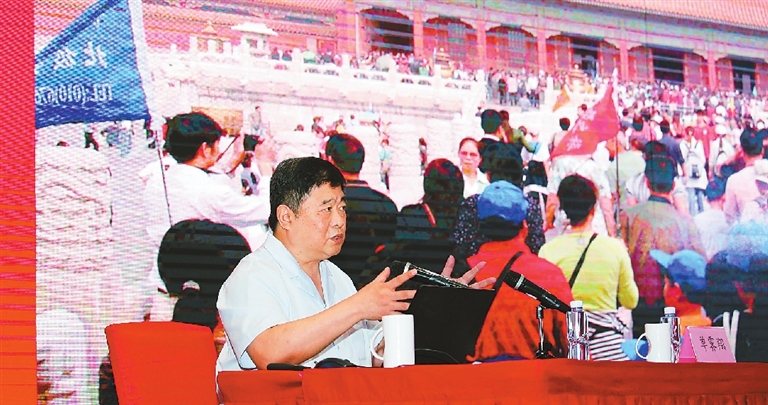

Wei Jie claudiamente@hotmail.com PUBLIC involvement is important to the protection of cultural relics, famed former Palace Museum curator Shan Jixiang told the crowd of people that gathered at the Vanke International Conference Center in Qianhai on Wednesday morning for his lecture on the protection and preservation of cultural relics and the innovation of traditional culture. Shan, the sixth curator of the Palace Museum in Beijing, shared with the audience about his seven years of service at the country’s most famous museum since January 2012. The self-titled “doorkeeper of the Palace Museum” retired in April this year. Dubbed an online celebrity curator by millions of Chinese netizens, Shan told the audience that traditional culture is best preserved when the general public is involved in its safekeeping, opposed to simply constructing brick-and-mortar buildings to shield cultural relics from damage. The Palace Museum, also known as the Forbidden City, used to act as a large warehouse for a variety of precious cultural relics that dated back several thousand of years. Most parts of the Palace Museum were kept closed to the public until recent years, and many of the large numbers of precious cultural relics had been wrapped up and locked behind closed doors in the palaces. Shan took bold steps to renovate the world’s most-visited museum and to better service its visitors. A facelift was conducted to turn several palaces in the imperial compound, which were being used as warehouses, into galleries. Shan took a set of terra-cotta warriors from Emperor Qin Shihuang’s mausoleum out of storage and had them put on public display at the Gallery of Sculpture. He designated a renovated palace as Gallery of Furniture to showcase the tables and chairs used by the imperial families, which were previously off limits to the public. Shan said keeping the cultural relics out of the public spotlight was not synonymous to protecting them. “When I walked past a statue of a Buddha stored in a closed palace the other day, I felt sad for it,” he said. “The statue was not meant to be kept in the dark.” When the Gallery of Sculpture was ready for visits, the Buddha statue was neatly placed on a shelf to greet visitors. “I found it full of charm,” he said. Thanks to Shan’s efforts, more than 80 percent of the Forbidden City became open to public visits in 2018. In 2012, only 30 percent of the museum was available for public viewing. Shan ordered the removal of nearby illegal structures that posed fire hazards to the all-wooden-structured buildings of the museum, and reclaimed all the houses around the museum that had been leased to private businesses and turned them into ticket offices, greatly shortening the lines to buy a ticket to visit the museum. The museum authority later rolled out an online appointment system, further shortening the time for getting a ticket for entry. The moves made visiting the museum a more delightful experience. Previously, visitors had to spend a couple of hours standing in lines at a crowded ticket sales office to buy a ticket and have their ID cards checked before entering the museum. Shan resorted to other high technology to create interactive platforms for museum visitors. LED lights lit up the once-dim exhibition areas in the palaces, which previously had no electrical wiring installed on fears that short circuiting could pose a fire hazard. Interactive touch-screens have been erected inside the museum, offering hands-on experiences to museum-goers, such as trying on the emperors’ clothing through augmented reality on screens. Museum-related apps of different themes have also been developed to help people better understand the history and background stories of each cultural relic exhibited at the museum. Under his reign at the Palace Museum, new vitality was brought to the cultural gem of the country, which gained unprecedented popularity among the younger generations. In 2018, 17.54 million people visited the Palace Museum, 70 percent more than the number of visitors to The Lourve in Paris, France, the second-most visited museum in the world. Shan’s open-armed approach to the protection of cultural relics ignited public interest in traditional culture and enhanced public awareness of the protection of cultural relics. A three-episode documentary on repairing cultural relics in the Palace Museum was rated 9.4 out of 10 points on Douban, one of the most influential websites for literature, music and movie reviews. “What touched me the most is that most of the likes (of the documentary) was given by young people, especially university students,” Shan said. The recruitment of 88 heritage restorers for the Palace Museum earlier this year attracted more than 40,000 applications. The more access to traditional culture and cultural relics the public gained, the more interest in preserving them grew, which, Shan said, will have a positive effect on the protection of cultural relics. Innovative cultural products related to the Palace Museum have been created and received warm market responses. The sales revenue from these cultural products reached 1.5 billion yuan (US$212.77 million) in 2017. Most of the funds were spent on academic research and education. According to Shan, all the staff of the Palace Museum aim to have all of the more than 1.86 million pieces of cultural relics put on public display when the Forbidden City celebrates its 600th anniversary next year. | 
